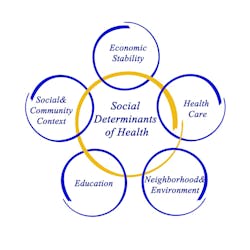Clinics, Hospitals Fine-Tune Social Determinant Screenings, Resource Connections
Provider organizations ranging from free clinics to rural hospitals are experimenting with tools and services that help them connect patients with community services such as housing, transportation and food pantries. Although closing the referral loop can be challenging, anecdotally some facilities say the screening process and follow-up seem to be having an impact on readmissions and outcomes.
Clinicians at CommunityHealth, a free clinic in Chicago for adults who are low-income and uninsured, has started using a referral platform for social service help. Based on its patients’ individual needs, language preference and a maximum distance they are willing or able to travel from their home, the NowPow platform can create a customizable report in their desired language from a database of programs and organizations available near the patient. (In November 2018, Healthcare Innovation covered a presentation by Stacy Lindau, M.D., a professor of obstetrics/gynecology and geriatrics at the University of Chicago who helped launch NowPow.)
Ornella Razetto, a licensed social worker and CommunityHealth’s social services manager, said that as part of the process of becoming a patient-centered medical home, CommunityHealth began using an assessment to screen patients for social determinants of health (SDOH). In May 2018 it began screening all its patients at the point of registration or during their renewal of registration. So far, it has screened approximately 2,100 patients. “What was most surprising to me is that historically the No. 1 resource requested by providers and patients has been food pantries,” she explained. However, in these surveys we saw that social engagement was by far the most requested category. This would include things like English as a Second Language, GED classes, yoga — activities where you were with other people. Those beat out food pantries, domestic violence assistance, housing assistance, which involve true physical needs.”
CommunityHealth began using the NowPow tool to connect people to resources in the community. It provides information translated into Spanish or Polish. “In Chicago, we have a huge population of Polish immigrants, but sadly there is not a lot of Polish-language information available,” Razetto said. Being able to email or text them or print out information for patients in their preferred language is amazingly helpful, she adds. “One of our goals is to find the resources to help close the loop by following up with patients and social service providers to see if patients really are taking advantage of the referrals and if it is having an overall impact on health outcomes.”
Matilde Rios, M.D., a voluntary physician, described her efforts with a few patients: “One was homeless and the other collected and sold cans in the summer — that was his only income. In the winter they didn’t work and didn’t have much food. They only had tortillas and rice. Their diabetes was completely uncontrolled. My idea was to connect these patients with the food pantry, but they were reluctant to go,” she said. “Because CommunityHealth started using NowPow, every time I saw these patients I had a printout of the closest pantries. I never asked the patients if they needed food. They would always say no because they are ashamed. I would say ‘we have these places and I want you to use them because if we don’t use them, they will close.’ The response was very good. They started going and said to me, ‘For the first time I have fresh vegetables in my house.’ As their diabetes began improving, I used NowPow to refer them to places they could start to exercise. It also has good resources for families dealing with early dementia. I think more physicians should be using it.”
A focus on readmissions
Nonprofit community hospital McLaren Port Huron in Michigan has incorporated patient screenings and technology from a company called Wellopp as part of a larger readmission reduction strategy. Holly Gould, clinical outcomes coordinator at McLaren, says the hospital initially partnered with Wellopp in March 2018 to deliver social determinants screenings to inpatients with chronic obstructive pulmonary disease (COPD) or congestive heart failure (CHF). These screenings included disease-specific education, questions, and information in addition to the standard SDOH content. Patients who take the screening receive regular text messages with medication reminders and wellness tips for up to 30 days after discharge. Patients receive a $10 gift card for filling out the initial screening and earn a total of $25 in gift cards if they follow the 30-day program through by answering all the text messages.
Gould said they customized the survey with disease-specific questions as well as the SDOH questions. One of the first text messages patients are asked is if they have seen a provider since they have been discharged or if they have an appointment. “For heart failure we would ask if they are monitoring their symptoms and weighing themselves. We would ask them if they felt they would have housing issues in the next year or trouble paying their utilities or whether they have enough money for food,” she said. “We thought those were some reasons patients could be readmitted. We also asked whether they could not make it to follow-up appointments because of transportation issues.”
Initially they tried working with the local 211 agency funded by United Way to help refer people to community resources, but that ended up not working as well as they hoped, so Wellopp itself took over the responsibility for coordinating care when patients are identified as having a strong need. The company developed a customized, local network of community resources that can be used to address patients’ SDOH needs and coordinates those services on the hospital’s behalf. “They figure out which resources would work best for the patient and help close the loop,” Gould says.
Nicole Ashley, chief operating officer of Wellopp, said it has tried working with 211 agencies but decided the company needed to take that accountability on itself, “because we believe in the power of identifying social determinants of health. If we can get these patients the support they need, we truly can improve their outcomes, but we can’t rely on a third party to do that because they might make one phone call and decide that is enough. We are willing to do multiple outreaches, following up afterwards and really fine-tuning that process.”
Gould said McLaren’s readmission rates are going down, and it has decided to expand the SDOH screening beyond the two conditions initially targeted. “We decided to add the SDOH survey for any patient to take even if they weren’t identified as high risk for readmission,” she said. “We are working on getting buy-in from case managers and making sure it fits into their schedules. We are working on structuring the survey a little bit differently to fit our population and help our patients see the benefit. There may also be potential for its use in our emergency department.”


